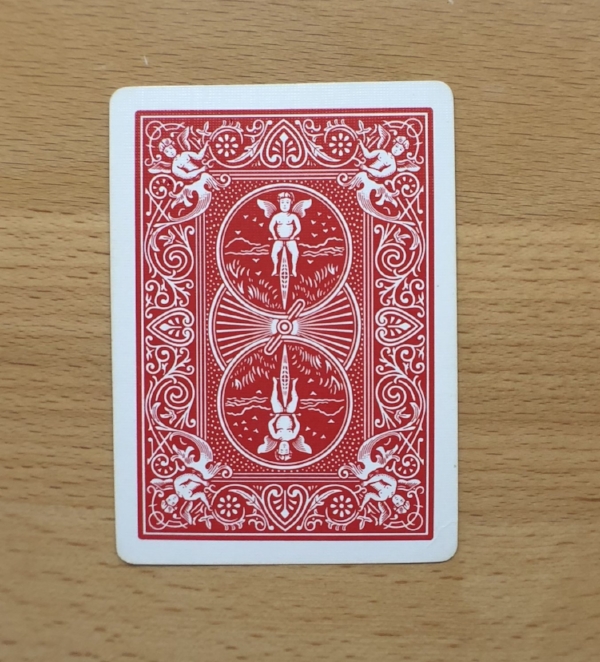A Bad Marked Deck (and Why to Make One)
/Following up on last week's post on the positive uses of exposure, here is a marked deck I made just for the purpose of exposing it. As I wrote in that post, if you "expose" a crappy marked deck to people, you are going to corrupt their understanding of what a marked deck is. They're going to assume it's something that requires a lot of scrutiny and not the sort of thing where cards can be coded in an easy way or in a way that is discernible from a distance.
Deception in the guise of openness is very powerful and disarming. And it's just fun to do. You come off as sort of a good guy, letting people in on some secrets. But what you're really doing is setting yourself up future success (and even setting up other magicians who may perform for these people in the future). As an amateur magician who performs for audiences consisting of the same people on a semi-regular basis, it makes sense to consider how things play out over the long term, rather than just fooling someone in the brief moment of a trick.
So let's say the subject of marked cards comes up. Occasionally a spectator will bring it up, even in a trick that would in no way benefit from the use of marked cards, just because they don't know enough about magic to bring up anything else. ("That red deck changed to a blue deck!... Does that used marked cards?") So the subject comes up, maybe you transition into it from talking about gambling, or maybe they mention it. Or perhaps you even ask for their help as you're trying to get better at identifying cards in this marked deck you just acquired.
When the topic comes up, I first start by feeding their head with a lot of untruths:
"Marked decks are kind of an urban legend. I mean, they exist, but they're hardly used by any magicians or gamblers."
"Think about it, the only area on the back of a card that is visible in many games is this top left corner of the back of the card."
"So while you can mark a card, you have such limited space to do it in. And you have to do it in a way that isn't obvious. Which means it has to be very small, so it's useless for magic because if they see you staring at the back of a card for any length of time, they'll know what's going on."
If someone talks about a marked deck they saw once where the value and suit were clear...
"Oh, yeah, they make those. But they're essentially gag gifts. You couldn't use them in a trick because anyone who wasn't braindead would spot them. And if you tried using them in a card game you'd get the shit kicked out of you."
"Do you want to see what a real marked deck looks like?" Which the always do.
And then I present them with a bad marked deck.
Here's the five of hearts. Can you spot the markings?
Don't bother.
Here is the marking system.
For Ace through 10, you will fill in the top half or the bottom half of those little triangles with a red marker. For J, Q, K you will blunt the ends of those little curl things.
For clubs, hearts, and spades you will block out the tips of the corresponding thingy at the top. For diamonds you'll leave it blank.
So the five of hearts will look like this...
I've actually come up with much worse marked decks. Ones that required binary code and even smaller markings and things like that. But if the deck is too ridiculously marked, then it comes off as a joke. You need to come up with something that is next to useless, but not entirely so.
As it is, you might think this is a ridiculous concept to have such tiny markings and that no one would believe it, but I've found it seems to make more sense and is more interesting to people than the actual markings we often use, like the Boris Wild Marked Deck, or something like that. Of course we would want the markings to be almost invisible. For a layperson, that is the logical way for a deck to be marked, not in a way that just anyone can see what the card is.
If someone says, "How does anyone use these in a game?" You just suggest that it's the type of thing someone practices for hours a day for many years until they get to the point where they can read a card in just a few seconds. "Obviously you can't read every card in play from a significant distance. If you could do that, so could everyone else at the table. But if you can get a glimpse of a few cards coming off the deck, or in your opponent's hands, or what the next card on top of the deck is, that can be enough to give you a significant advantage."
Keep in mind, most people have seen ZERO marked decks in their life, they've just heard the term. So, going forward, their idea of what a marked deck is will be heavily influenced by this experience. Which means as long as you're not staring intently at the back of a card, they will generally assume marked cards aren't in play. This can be very helpful given that marked decks are one of the few magic secrets the general public has heard of. And the notion that maybe you created a bad version of a marked deck to taint their understanding of what they are and how they can be used is a level of deviousness I don't think most people will ever consider.



